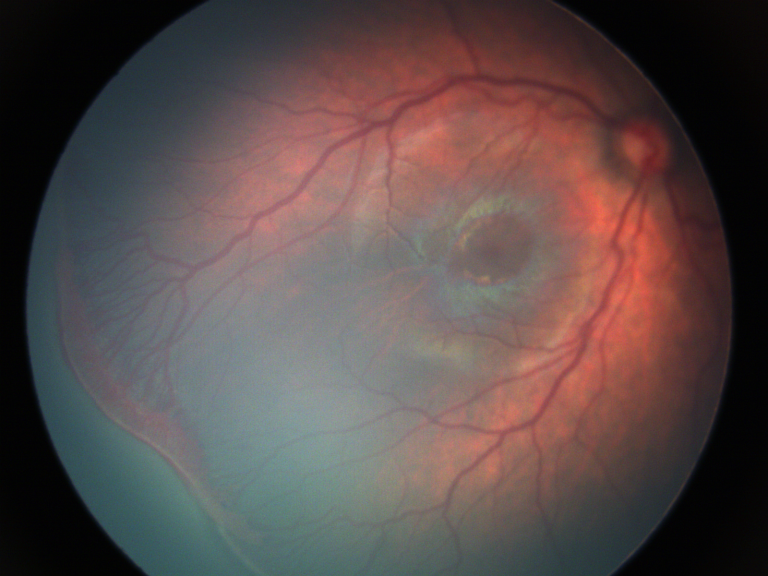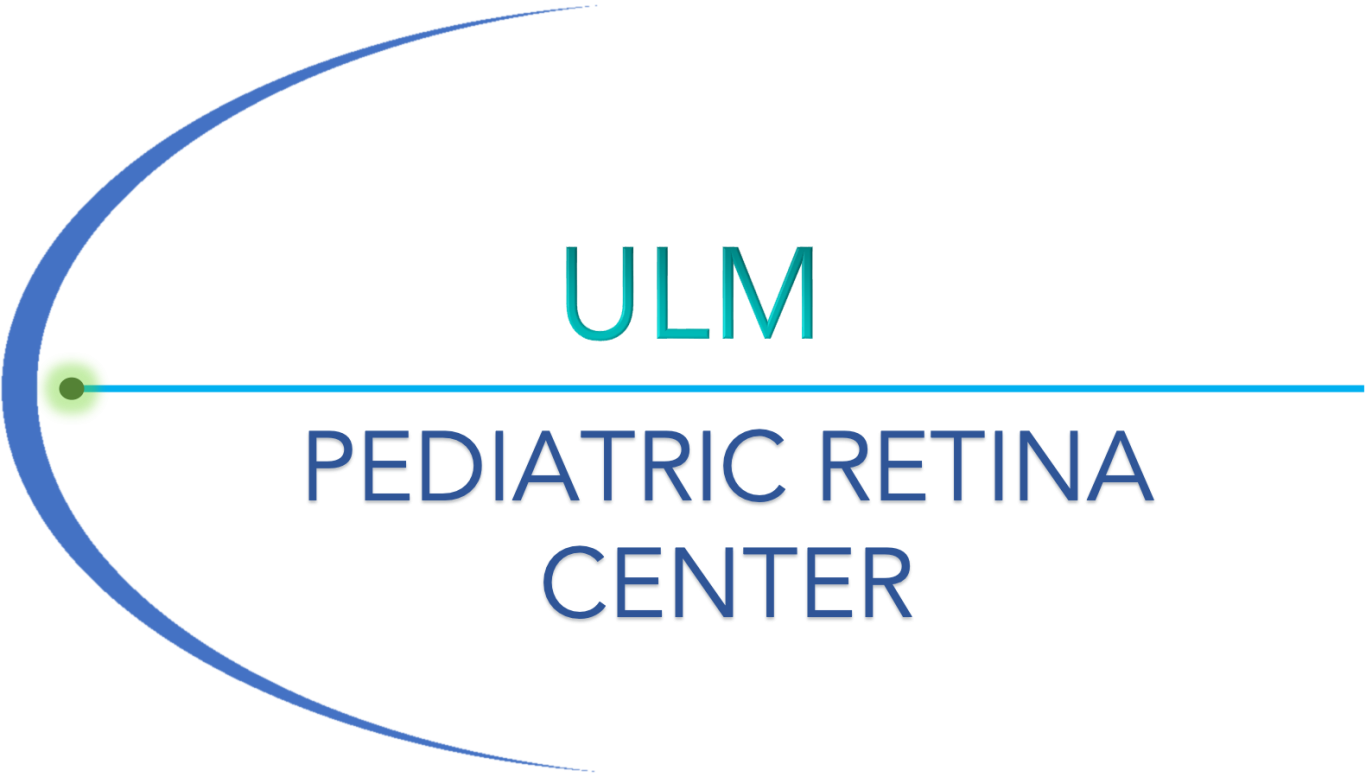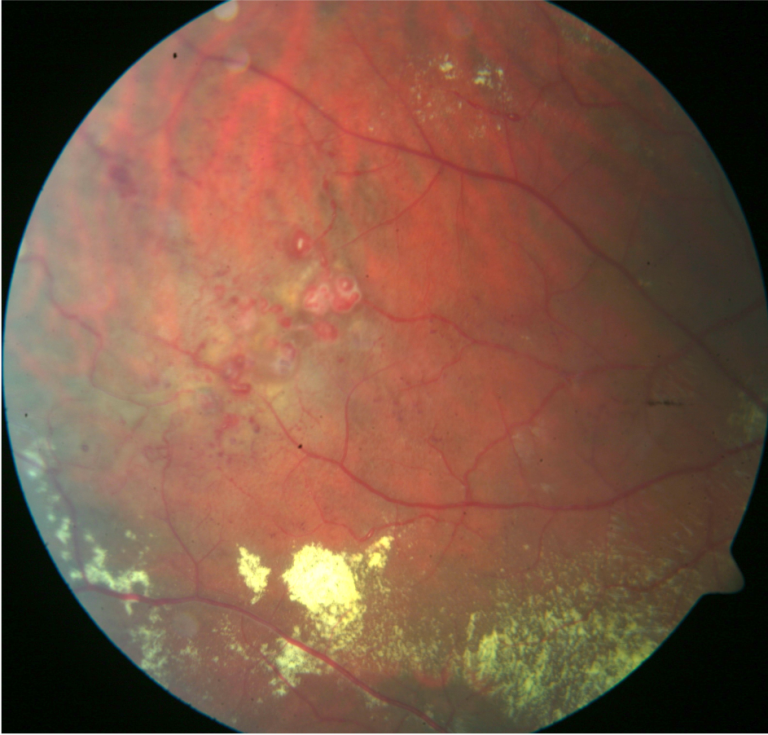
Retinopathy of praematurity
Retinopathy of prematurity (ROP) is a developmental vascular disorder of the retina affecting premature infants. It is characterized by abnormal retinal blood vessel development, which can lead to retinal detachment and subsequent vision impairment or blindness if left untreated.
The primary risk factors for ROP include extremely low gestational age, birth weight below 1500 g, prolonged exposure to supplemental oxygen, mechanical ventilation, sepsis, and intraventricular hemorrhage.
Although ROP may spontaneously resolve as the infant matures, regular ophthalmologic examinations are crucial to monitor disease progression and prevent complications. These evaluations are performed by our specialized ophthalmologists using advanced imaging technology such as RetCam for precise documentation of retinal findings.
In cases where intervention is necessary, timely treatment is essential to mitigate the risk of severe visual impairment. If untreated, advanced stages of ROP can result in irreversible vision loss or complete blindness.
The following treatment modalities are employed for ROP management:
- Retinal laser photocoagulation
- Intravitreal injection of anti-VEGF agents
Vitreoretinal Dystrophies

Vitreoretinal dystrophies represent a heterogeneous group of inherited retinal disorders that primarily affect the vitreous body and retina. Although they are generally rare, several vitreoretinal dystrophies manifest in childhood and can significantly impact visual development if not detected early. These conditions may lead to serious vision impairment or blindness due to progressive retinal degeneration, retinal detachment, and other complications. Early diagnosis and timely intervention are crucial to prevent irreversible damage to the retina and to manage complications such as retinal detachment, vitreous traction, and retinal vascular abnormalities. Regular ophthalmologic examinations are vital for children at risk of these inherited conditions to ensure prompt diagnosis and management.
Familial Exudative Vitreoretinopathy (FEVR)
Familial Exudative Vitreoretinopathy (FEVR) is a genetic disorder characterized by abnormal development of retinal blood vessels, leading to retinal exudation (fluid leakage), neovascularization (abnormal blood vessel growth), and vitreoretinal traction. These abnormalities typically result in impaired retinal function and, if untreated, can lead to retinal detachment, resulting in severe and permanent vision loss. FEVR is diagnosed primarily in childhood, and its inheritance pattern varies, including X-linked, autosomal dominant, and autosomal recessive forms. Early detection is crucial, as it allows for timely interventions, such as laser photocoagulation or anti-VEGF therapy, to manage neovascularization and prevent retinal detachment.
Juvenile (X-linked) Retinoschisis
Juvenile retinoschisis, primarily inherited in an X-linked pattern, is characterized by the splitting or “schisis” of the retinal layers, particularly affecting the macula. This condition primarily impacts males and typically manifests during early childhood, with symptoms ranging from mild visual impairment to more severe vision loss. The retinal splitting leads to disruption of the normal retinal architecture and can cause retinal detachment in some cases. While the disease progresses slowly, early intervention is essential to prevent complications and to monitor for retinal detachment, which can exacerbate vision loss. Juvenile retinoschisis is often diagnosed through clinical examination and imaging techniques such as optical coherence tomography (OCT).
Vitreoretinal Degeneration in Stickler Syndr.
Stickler syndrome is a connective tissue disorder associated with mutations in the collagen genes, particularly COL2A1, which can lead to vitreoretinal degeneration, retinal detachment, and other ocular abnormalities such as myopia, cataracts, and glaucoma. Ocular manifestations typically develop in childhood and can be severe, with retinal detachment occurring in up to 50% of affected individuals. The vitreoretinal changes in Stickler syndrome are due to structural weaknesses in the retinal and vitreous tissues, leading to traction and potential retinal detachment. Early diagnosis is essential for managing the ocular complications and preventing irreversible vision loss.
Cone-Rod Dystrophy (CRD)
Cone-Rod Dystrophy (CRD) is a group of inherited retinal degenerations that cause progressive loss of both cone and rod photoreceptor function, leading to visual acuity loss, color vision deficits, and sometimes, vitreoretinal changes. Although CRD is typically associated with adult-onset progressive vision loss, some forms of the disease manifest during childhood. In childhood-onset CRD, retinal changes, including macular degeneration and retinal vascular abnormalities, may occur, leading to further vision deterioration.
Coats' disease
Coats' disease is a rare, non-hereditary retinal vascular disorder predominantly affecting males (male-to-female ratio of at least 3:1) and characterized by unilateral (95%) and progressive telangiectasia with associated subretinal exudation. The condition often leads to retinal detachment and vision loss, typically presenting in children under the age of 8, although cases have been reported in infants and older individuals.
The pathological changes include abnormal retinal blood vessels, which can result in extensive subretinal exudation and progressive retinal detachment. Treatment strategies depend on the clinical presentation and disease stage and are performed by our vitreoretinal specialists. Available therapeutic options include:
- Retinal laser photocoagulation
- Cryotherapy
- Vitreoretinal surgery
- Intravitreal pharmacotherapy


Pediatric Ocular Trauma
Pediatric Ocular Trauma refers to eye injuries occurring in children, which can involve the cornea, lens, retina, vitreous body, or orbit. These injuries may result from various causes, including accidents, sports injuries, or child abuse. Pediatric ocular trauma often presents with significant risks for long-term visual impairment, including blindness, if not treated promptly. Early diagnosis and rapid intervention are crucial to prevent complications such as retinal detachment or intraocular hemorrhage which can lead to permanent vision loss. Immediate medical attention is essential to preserve vision and minimize long-term sequelae.